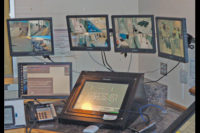The combination of multiple security threats and variable environmental factors can make municipal water facilities especially challenging sites to secure. As with any outdoor installation, false alarms triggered by blowing foliage or debris are always a concern. Animals tend to be a bigger problem at water treatment plants because of the rural locations and their attraction to the odors emitted by the facilities.
Security systems must also address problems specific to the nature of the operations of this type of plant. “It’s not just protection from theft; it’s protection against bigger threats,” says Howard Manson, chief executive officer of Today’s Integration Inc. Having installed security systems at several water treatment plants over the years, the Houston based security dealer has developed a specialty in meeting the unique challenges presented by this type of installation.
Protecting against theft of copper pipe and tampering with the water supply are top priority. A robust security system can help mitigate liability risks as well. Accidental or deliberate release of hazardous chemicals by vandals or trespassers can pose a danger to the individuals responsible, as well as employees and residents of the surrounding areas.
“Districts that put in quality security systems are putting in the best effort they can to assure their operators know of incidents that they may otherwise not know of until it’s too late,” says Manson, citing a recent incident in which a group of teenagers broke into an under-secured facility and were roughhousing with barrels of chlorine. The safety mechanisms on the barrels were the only thing that prevented a tragic outcome.
For a recent installation at a utility district water plant in the Houston area, Today’s Integration designed a system to secure sensitive areas from these varied threats. Like many pre-existing structures, the plant had been built without prior consideration of a security system. Limited access to power and availability of suitable mounting locations created additional design challenges. “When building these outside facilities, no one thinks about security until someone steals the copper,” Manson says.
Seven PROTECH Piramid XL2 outdoor motion sensors were installed to provide coverage of key sections of the perimeter and to target sensitive equipment and storage areas. The SDI-77XL2 sensor features a stereo Doppler microwave detector combined with a dual-element passive infrared sensor. The independent sensors are “And Gated” to reduce the potential for false alarms by triggering an alert only when movement is simultaneously detected by both systems. Manson appreciates the dial setting to control sensitivity detection levels. While many sensors have only two sensitivity levels, the XL2’s digital sensitivity control features a ten-position dial to adjust the amount of movement required to trigger an alarm. A similar digital range control dial allows for refined adjustments to the overall detection area. A durable metal housing protects the sensor components from the elements, as well as providing protection against RFI and EMI interference.
“The XL2 sensor is extremely flexible and can fit into hundreds of different applications,” says Jeffrey Morris, national sales manager for PROTECH, located in Sparks, Nev. “We can interface with any system: SCADA, NVR, DVR or directly into IP cameras.” Although the option was not utilized for this installation, Morris notes, “We are starting to see a lot of use of our motion sensors to trigger remote [video] verification.”
Manson installed two GE Interlogix NX-650N wireless transmitters in each of four sensors located far from an available power source. “It’s a significant cost savings to be able to use a wireless transmitter,” Manson says, noting that the XL2 sensors make it easy for a dealer to install a wireless device inside of them, thereby avoiding the expensive alternative of digging a trench to run alarm cables to the sensors.
The XL2 sensors are supported by a GE Interlogix NetworX NX-8E control panel, NX-548E wireless receivers, and NX-148E keypads. A GE Interlogix NX-592GSM cellular backup unit from Alarm.com allows for two-way remote interface with the unit and incorporates a host of features for the user.
Manson says the district board was pleased with the security afforded by this system. Like many of his clients, they were pleasantly surprised to learn that the system could benefit plant operations in other ways. “These sensors can be used for more than just security, but as a management tool,” says Manson.
Programming the system to send alerts for events, such as arming and disarming system, can enhance efficient operation of the facility. Notifications triggered by movement, or lack of movement, within a given area and time, can be used to provide an additional level of safety for employees and others. If an employee enters an area where hazardous chemicals or dangerous equipment are present and does not exit the area within a given time, the operator can be notified, enabling him to investigate the problem and send help quickly if needed.
Manson says that his clients are more likely to use all of the features if they are user-ready from the beginning. He says that it is not enough to just tell them about the options, it’s necessary to deploy them and make them easy to use. Doing so not only increases the current user’s satisfaction, but also creates a built-in marketing tool for the security dealer, especially when working with water treatment facilities, where word-of-mouth recommendations are extremely important. “If you don’t set it up, they’ll never use it and see the benefits,” says Manson. “If you set it up for them, then they’ll use it and appreciate it.” And they’ll tell others.








